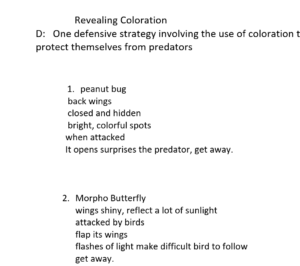いきなりですが、TOEFLを話せるためには、テンプレートの暗記とひたすら練習するのみです。
TOEFLの勉強を始めた頃の私は、どう勉強していいかわからず、時間を測っても焦って何も答えられないうちにタイムオーバーという状態でした。
が、今回紹介する勉強法を身に付けて練習を積み重ねたら数か月後にはものすごく上達しました。
TOEFLのスピーキングは向き不向きではなく、正しいやり方で訓練することで必ず点数が上がります。そしてそれはテンプレートを暗記することとノートを正しく取ることです。
今回はスピーキングIntegrated Task3の答え方をもとに解説していきます。Task1 とTask2を読んでない方はそちらを先に読んでから戻ってきてくださいね。
Task 3 質問の流れ
まずTask3は以下のような流れになります。
- 与えられたリーディング文を45秒で読む
- リスニングを聞く(レクチャー関連)
- 30秒で準備
- 60秒で話す
詳細はETSのWebサイトでご確認ください。
ノートの取り方ー重要!
まず初めに紙に以下のことを書きます。

- T(Title) のところはリーディングのタイトルを書きます。
- D(Definition) にはそのタイトルを説明している一文を書き抜きます。
- リスニングの内容はそのリーディングを詳しく説明する例が一つや二つ与えられます。その名前と具体的な理由文のところを出来るだけノートに取ります。
テンプレートの暗記-超重要!
テンプレートの暗記は必須です。ノートに書いた内容をテンプレートに落とし込んでいくことによって流暢な英語で話すことが出来ます。
The professor gives an example of_________to illustrate this.
He (she) says _________So this example (these examples) clearly illustrates _____________________.
例題とその解答例
では例題をもとに解説していきます。こちらはETS のSpeaking task 3のPractice test から引用しました。
their surroundings. But its back wings—which are usually closed and hidden—have these bright, colorful spots on them. And when the peanut bug’s attacked, it suddenly opens its back wings, and out pop these big, bright colors. And that surprises the predator, and gives the peanut bug a chance to get away. Um, and then you have a butterfly … called the morpho butterfly. And parts of the morpho butterfly’s wings are very shiny, they reflect a lot of sunlight; when this butterfly is resting, this shiny part of its wings is hidden … Now, morpho butterflies are often attacked by birds … So when a bird approaches, the morpho flies away …and when the morpho flap its wings, all the bird can see are flashes of light reflected from the morpho’s wings. Those flashes of light make it very difficult for the bird
to follow the morpho, and the morpho is usually able to get away.
完成したノートはこんな感じです

テンプレートに入れ込んでいきます
The reading is about revealing coloration which the passage defines as a defensive strategy involving the use of coloration to protect themselves from predators.
The professor gives an example of peanut bug to illustrate this.
He (she) says peanut bugs have back wings that are closed and hidden, and they have bright and colorful spots on them. When attacked, they open and surprise the predator so they are able to get away.
Another example is the Morpho butterfly. Their wings are shiny and reflect a lot of sunlight. When attacked by birds, they flap wings that flash which makes it difficult for birds to follow. So these examples clearly illustrate revealing coloration.
まとめ
テンプレートの暗記は最初は大変ですが、何回も繰り返しているうちに自然に口から出るようになります。ノートは全て正確に書こうとしたら時間が無いので、自分が分かるような略語や記号を使って早く書ける練習します。自分の声を録音して聞き、流暢に言えるようになるまで何度も練習しましょう。
この勉強法で私のスピーキング力はかなり上達しました。諦めずに練習したら必ず点数は上がります!
早くTOEFLのストレスから解放されますように♬
こちらも参考にしてください。





コメント